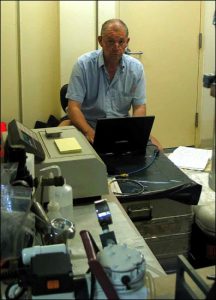Dispatch 09 – European team looks for warmer waters
Why is a University of Brussels, Belgium research team that is usually involved with studies of the ocean carbon cycle in the Southern Ocean looking for in the warmer waters off Hawaii?

Frank Dehairs working over his lap top in the laboratory on the R/V Kilo Moana. (photo by Mark Gall)
During a 2001 cruise in the icy Southern Ocean waters, we had the opportunity to collaborate with Ken Buesseler, Tom Trull and Phil Boyd, comparing different methodological and conceptual approaches for assessing the biological carbon pump and deep ocean organic matter breakdown. Ken’s VERTIGO plans, with focus on export and fate of plankton produced organic carbon in the twilight zone, were ripening in those days and he proposed us to join this VERTIGO team. For us this meant a unique opportunity to test our concepts about the biological carbon pump in a very different oceanic setting and thus verify global applicability of our understanding of the processes we study. We submitted a research proposal to our science foundation (FWO-Flanders), which met success. So here we are with a team of two, made up of one Belgian and one French scientist, certainly a reflection of ongoing integration of the European scientific community.
In order to address the carbon flux from surface layer to the deep ocean we apply different approaches. One of these consists in assessing that fraction of phytoplankton production that is left over to sink out of the surface waters and decompose deeper in the water column. This type of production is called New Production and is fueled by nitrogen mixed into the surface waters from the deep ocean and also, importantly in this study area, captured from the atmosphere by the activity of nitrogen fixing cyanobacteria. To resolve the uptake of these specific nitrogen substrates by the plankton we add either nitrate or nitrogen gas labeled with the heavy stable isotope of nitrogen (i.e. nitrogen with atomic mass 15; most natural nitrogen having atomic mass 14) to a seawater sample and check after incubation how much of that heavy nitrogen isotope ends up in the particles we filter (we also run separate experiments with labeled ammonium and nitrite, two other important nitrogen substrates for phytoplankton growth). The sum of the nitrate and nitrogen gas supported primary productions reflects how much nitrogen (and therefore carbon) is exportable to the deep ocean. So there’s lots of incubation work and filtering going on, but results will have to await later mass spectrometric analysis when we are back home.
A second approach consists in estimating the breakdown of plankton material in the deep ocean using the “barium-barite proxy”. This works as follows. Plankton detrital material settles out of the surface layers as aggregates. These represent tiny micro-environments inside which chemical reactions can proceed which do not occur in the ambient water. Formation of the barium sulphate mineral barite is such a reaction. Upon breakdown of the carrier aggregates in deeper waters, these tiny crystals (sizes of 1/1000 of a mm and even less) get dispersed in the water and persists over longer time scales than does the organic aggregate matrix in which they were formed. In this way they represent the memory of former surface water biological production and plankton matter oxidation in the deep waters. So we sample suspended matter at different depths in the upper 1000 m, using the ship’s CTD/rosette bottle sampler and filter off the particles on membrane filters. These are saved for later analysis of elemental composition in the home laboratory. We do this also in parallel with Jim Bishop’s impressive large volume in-situ filtration system (MULVFS), with the aim of comparing both CTD/Rosette bottle and pumping sampling systems.

Sunset deployment of CTD/Rosette water sampler used to collect barium samples by Dehairs and other scientists. (photo by Mark Gall)
Both these approaches are complementary to the one that looks at the 234-thorium deficit in the upper water column (this is done by Ken’s group) and to the many different sophisticated particle stock and flux experiments that our American, Australian and New Zealand colleagues run on board. The deployment and recovery of autonomous sampling devices is truely impressive, and in comparison our gear is more of the bucket and rope type!
As a final note we’d like to stress that being on board this VERTIGO cruise is great! Spirits are high thanks to the excellent collaboration between colleagues, the efficient cooperation of the Kilo Moana’s crew and thanks to the outstanding gastronimical conditions. However this European team is longing for a good glass of Bordeaux to enjoy with meals, but unfortunately this is a non-existing product on board!
— Tom Trull